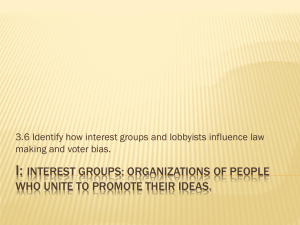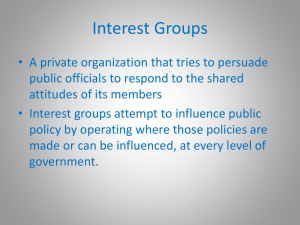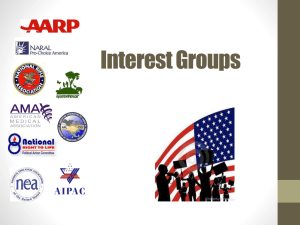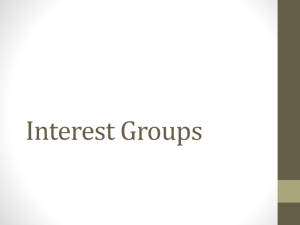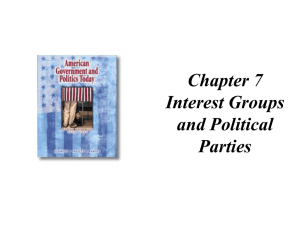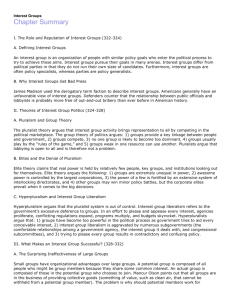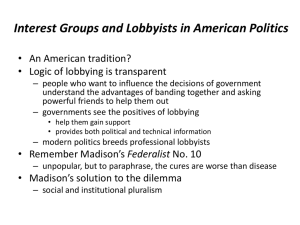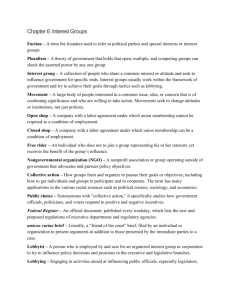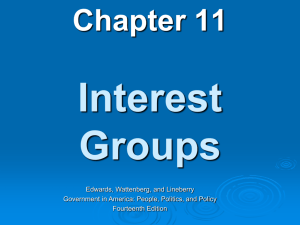AP GOV/POLITICS
advertisement
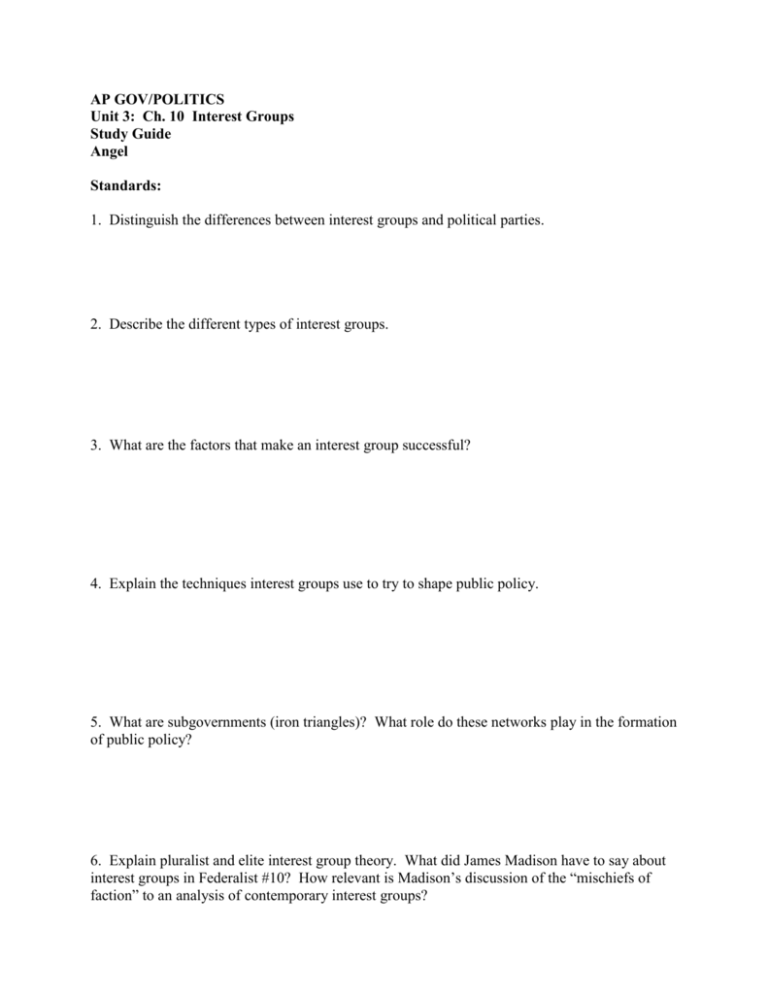
AP GOV/POLITICS Unit 3: Ch. 10 Interest Groups Study Guide Angel Standards: 1. Distinguish the differences between interest groups and political parties. 2. Describe the different types of interest groups. 3. What are the factors that make an interest group successful? 4. Explain the techniques interest groups use to try to shape public policy. 5. What are subgovernments (iron triangles)? What role do these networks play in the formation of public policy? 6. Explain pluralist and elite interest group theory. What did James Madison have to say about interest groups in Federalist #10? How relevant is Madison’s discussion of the “mischiefs of faction” to an analysis of contemporary interest groups? TERMS: Interest group Pluralist theory Elite theory Sugbgovernments (iron triangles) Free rider Single issue group Lobbying Electioneering PAC Amicus curiae brief Class action lawsuit AP GOV/POLITICS CH. 10—INTEREST GROUPS LECTURE NOTES ANGEL Interest Groups: organizations dedicated to a particular political goal or to a set of unified goals. Group members often share a common bond—religious (Christian Coalition), racial (NAACP), professional (Am. Medical Assoc.), or issues (Sierra Club) to name some examples. Interest groups are LINKAGE INSTITUTIONS—they link citizens with the government. Other linkage institutions are the media and political parties. Interest groups allow a person to magnify his/her preferences and voice on candidates and issues. Like political parties, interest groups try to influence the outcome of elections and legislation. Unlike political parties, however, they do not nominate candidates, nor do they normally try to address a wide range of issues. Categories of Interest Groups Economic groups: business groups—U.S. Chamber of Commerce and National Association of Manufacturers (examples) labor groups—AFL-CIO, United Auto Workers professional organizations—American Bar Association These groups tend to be well funded and have large constituencies. They are usually the most powerful interest groups in Washington, D.C. Public Interest groups: nonprofit groups organized around public policy issues consumer issues—Common Cause and Public Citizen (Ralph Nader’s group) environmental issues—Sierra Club National Rifle Assoc. (NRA) National Right to Life Many members of these groups are more likely than other voters to use a single issue as a litmus test for candidates. A candidate who advocates gun control runs the risk of losing the votes of all 3 million NRA members. Government groups: governor’s association, mayor’s association, etc. Activities of Interest Groups Used to Shape Public Policy Interest groups use many tactics to persuade Congress, the President, the Judiciary, and federal bureaucrats: Electioneering—helping to get candidates elected, mobilizing voters Direct lobbying—meeting with government officials to suggest legislation and provide facts and research regarding their positions Testifying before Congress—expert witnesses Political donations—corporations, trade groups, and unions are forbidden by law to make donations, but get around the law by forming PACs to make donations Court actions—class action lawsuits and/or amicus curiae briefs Helping to draft legislation—providing expert and technical information to legislators regarding public policy Rallying their membership—getting members to write, phone, fax, email legislators in support of a piece of legislation Propaganda—press releases, advertisements, etc. Socializing—parties, political events, and social functions where lobbyists forge relationships with government officials Endorsements—this includes ratings based on voting records—a high rating constitutes an implicit endorsement Limits on Lobbying Federal Regulation of Lobbying Act, 1946: Lobbyists must register with the government Lobbyists must publicly disclose their salaries, expenses, and the nature of their activities Buckley v. Valeo, 1976: Former legislators must wait one year before lobbying Congress directly; however, they may lobby the executive branch immediately. They may also work as consultants to interest groups. Former legislators working as lobbyists and using the connections they made as government officials is known as the revolving door. Federal Election Campaign Act, 1971 and 1974 Corporations, unions, and trade associations are forbidden from donating directly to candidates; however, they may form PACs as a means of raising funds for donations for campaigns. Restrictions on PACS: Must raise money from at least 50 contributors Must donate to at least five different candidates May not donate more than $5000 per year to any single candidate The Supreme Court has likened lobbying and interest group activities to free expression, and therefore they are constitutionally protected. PACs contribute predominantly to incumbents who are likely to win reelection, hoping thereby to purchase access to legislators in the next Congress.
